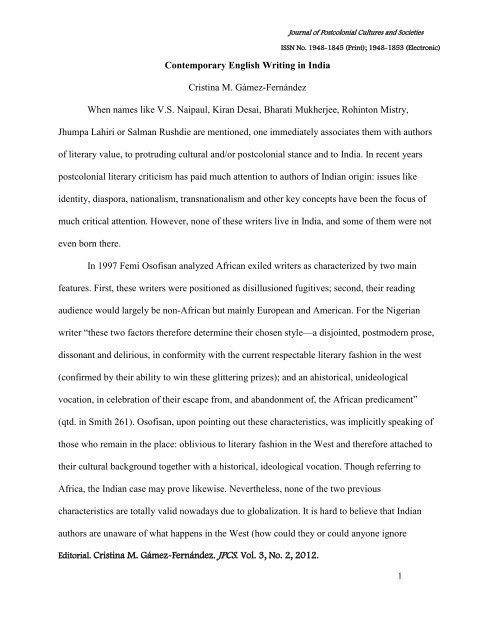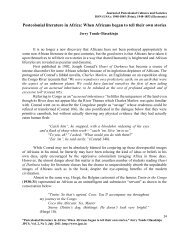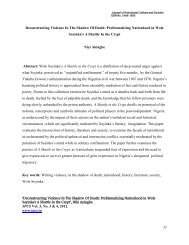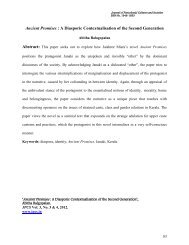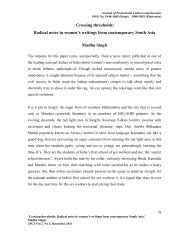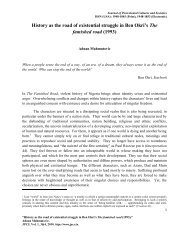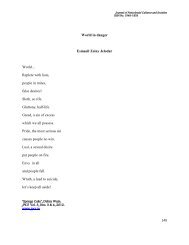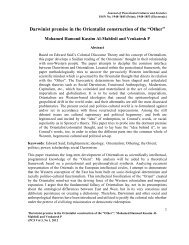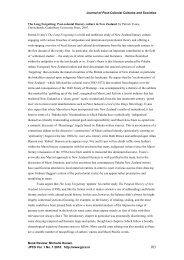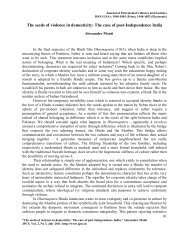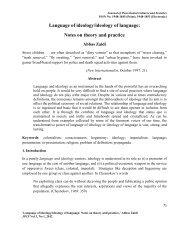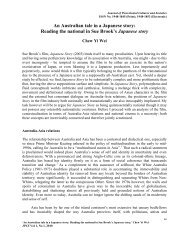Contemporary English Writing in India - JPCS
Contemporary English Writing in India - JPCS
Contemporary English Writing in India - JPCS
Create successful ePaper yourself
Turn your PDF publications into a flip-book with our unique Google optimized e-Paper software.
Journal of Postcolonial Cultures and Societies<br />
ISSN No. 1948-1845 (Pr<strong>in</strong>t); 1948-1853 (Electronic)<br />
<strong>Contemporary</strong> <strong>English</strong> <strong>Writ<strong>in</strong>g</strong> <strong>in</strong> <strong>India</strong><br />
Crist<strong>in</strong>a M. Gámez-Fernández<br />
When names like V.S. Naipaul, Kiran Desai, Bharati Mukherjee, Roh<strong>in</strong>ton Mistry,<br />
Jhumpa Lahiri or Salman Rushdie are mentioned, one immediately associates them with authors<br />
of literary value, to protrud<strong>in</strong>g cultural and/or postcolonial stance and to <strong>India</strong>. In recent years<br />
postcolonial literary criticism has paid much attention to authors of <strong>India</strong>n orig<strong>in</strong>: issues like<br />
identity, diaspora, nationalism, transnationalism and other key concepts have been the focus of<br />
much critical attention. However, none of these writers live <strong>in</strong> <strong>India</strong>, and some of them were not<br />
even born there.<br />
In 1997 Femi Osofisan analyzed African exiled writers as characterized by two ma<strong>in</strong><br />
features. First, these writers were positioned as disillusioned fugitives; second, their read<strong>in</strong>g<br />
audience would largely be non-African but ma<strong>in</strong>ly European and American. For the Nigerian<br />
writer “these two factors therefore determ<strong>in</strong>e their chosen style—a disjo<strong>in</strong>ted, postmodern prose,<br />
dissonant and delirious, <strong>in</strong> conformity with the current respectable literary fashion <strong>in</strong> the west<br />
(confirmed by their ability to w<strong>in</strong> these glitter<strong>in</strong>g prizes); and an ahistorical, unideological<br />
vocation, <strong>in</strong> celebration of their escape from, and abandonment of, the African predicament”<br />
(qtd. <strong>in</strong> Smith 261). Osofisan, upon po<strong>in</strong>t<strong>in</strong>g out these characteristics, was implicitly speak<strong>in</strong>g of<br />
those who rema<strong>in</strong> <strong>in</strong> the place: oblivious to literary fashion <strong>in</strong> the West and therefore attached to<br />
their cultural background together with a historical, ideological vocation. Though referr<strong>in</strong>g to<br />
Africa, the <strong>India</strong>n case may prove likewise. Nevertheless, none of the two previous<br />
characteristics are totally valid nowadays due to globalization. It is hard to believe that <strong>India</strong>n<br />
authors are unaware of what happens <strong>in</strong> the West (how could they or could anyone ignore<br />
Editorial. Crist<strong>in</strong>a M. Gámez-Fernández. <strong>JPCS</strong>. Vol. 3, No. 2, 2012.<br />
1
Journal of Postcolonial Cultures and Societies<br />
ISSN No. 1948-1845 (Pr<strong>in</strong>t); 1948-1853 (Electronic)<br />
Internet?) and also difficult to simply exclusively associate their writ<strong>in</strong>gs with their cultural<br />
background, as if they were liv<strong>in</strong>g <strong>in</strong> a plastic bubble. In this sense, this issue of the Journal of<br />
Post-Colonial Cultures and Societies has attempted to provide a space for discussion and<br />
analysis that helps to deepen our current understand<strong>in</strong>g of contemporary <strong>English</strong> writ<strong>in</strong>g <strong>in</strong> <strong>India</strong><br />
through a variety of critical stances.<br />
Yet, the preparation of this volume has given rise to coexist<strong>in</strong>g oppos<strong>in</strong>g forces. The<br />
whole message and core idea that contemporary <strong>English</strong> writ<strong>in</strong>g <strong>in</strong> <strong>India</strong> deserved special<br />
attention was utterly buried by the avalanche of essays deal<strong>in</strong>g with some of the abovementioned<br />
authors. This was a sign of the great attention attracted by the literary quality of such<br />
writers and the scarce <strong>in</strong>terest on the part of the academia to <strong>India</strong>n writers liv<strong>in</strong>g <strong>in</strong> <strong>India</strong>.<br />
However, those few accepted papers (four out of only eight received) engage with connections<br />
between history, economics, literature, society, religion, and so on. Indeed, these articles devote<br />
to the analysis of how contemporary <strong>India</strong>n writers deal with cultural and social problems or<br />
<strong>India</strong>n public issues through literature. This approximation may offer an illum<strong>in</strong>at<strong>in</strong>g perspective<br />
complementary to that other more common approach that one usually encounters.<br />
The reason why literature written <strong>in</strong> <strong>English</strong> by <strong>India</strong>n authors liv<strong>in</strong>g <strong>in</strong> <strong>India</strong> does not<br />
receive an equal amount of <strong>in</strong>terest may possibly thus lie <strong>in</strong> a dom<strong>in</strong>ant Westernized critical<br />
approach. It is quite strik<strong>in</strong>g to f<strong>in</strong>d out that all the authors contribut<strong>in</strong>g to this issue have <strong>India</strong>n<br />
names. Hence my statement po<strong>in</strong>t<strong>in</strong>g out that a Westernized critical approach may have had<br />
someth<strong>in</strong>g to do with this situation. It can be a symptom of the biased stance <strong>in</strong> Western<br />
academia but also a proof of the difficulty of approach<strong>in</strong>g an utterly different cultural paradigm,<br />
not to mention historical, sociological, literary or l<strong>in</strong>guistic, from one’s own. Be that as it may, I<br />
Editorial. Crist<strong>in</strong>a M. Gámez-Fernández. <strong>JPCS</strong>. Vol. 3, No. 2, 2012.<br />
2
Journal of Postcolonial Cultures and Societies<br />
ISSN No. 1948-1845 (Pr<strong>in</strong>t); 1948-1853 (Electronic)<br />
believe that still it is worth the effort to critically ponder on the weight of <strong>English</strong> writ<strong>in</strong>g <strong>in</strong><br />
<strong>India</strong>, whether it is prose, poetry or drama. This would allow the (Western or not) academia to<br />
foster and elicit a trend of analysis centered on <strong>English</strong> writ<strong>in</strong>g <strong>in</strong> <strong>India</strong> which consciously<br />
rema<strong>in</strong>s unaware of publish<strong>in</strong>g bus<strong>in</strong>ess mach<strong>in</strong>ery and its sparkl<strong>in</strong>g awards, and which delves<br />
<strong>in</strong>to the literary phenomenon as a way to reach a new understand<strong>in</strong>g of <strong>India</strong>n issues from<br />
with<strong>in</strong>.<br />
I am conscious of the difficulty of the proposal though. Most writers <strong>in</strong> <strong>India</strong> are at least<br />
bil<strong>in</strong>gual and <strong>in</strong> many cases they speak four or five languages. Makarand Paranjape, <strong>in</strong> deal<strong>in</strong>g<br />
with the <strong>India</strong>n novelist Kiran Nagarkar, tackles the problem of establish<strong>in</strong>g a tradition <strong>in</strong> fiction<br />
writ<strong>in</strong>g exclusively <strong>in</strong> <strong>English</strong>:<br />
There is another k<strong>in</strong>d of critique of this notion of a tradition of <strong>India</strong>n <strong>English</strong><br />
writ<strong>in</strong>g . . . Accord<strong>in</strong>g to this other argument you cannot constitute a tradition of<br />
<strong>India</strong>n writ<strong>in</strong>g or <strong>India</strong>n fiction, which takes <strong>in</strong>to account the literary productions<br />
<strong>in</strong> all the major <strong>India</strong>n languages. That is to say that monol<strong>in</strong>gualism is a colonial<br />
imposition; to carry it forward to this date would be to reify a colonial legacy. The<br />
cultural complexity that is <strong>India</strong> will not respond to such an imposition of a<br />
monol<strong>in</strong>gual literary tradition. The argument here is that because <strong>India</strong>n <strong>English</strong><br />
creativity is a k<strong>in</strong>d of bil<strong>in</strong>gual creativity <strong>in</strong> the first place, you cannot consider<br />
<strong>India</strong>n <strong>English</strong> literature <strong>in</strong> isolation. There is no <strong>India</strong>n <strong>English</strong> tradition as such<br />
but traditions which talk to works written <strong>in</strong> other <strong>India</strong>n languages. (9-10)<br />
Paranjape believes that “to talk of a tradition of <strong>India</strong>n <strong>English</strong> writ<strong>in</strong>g is therefore considered<br />
unsatisfactory” (10). Yet the body of <strong>English</strong> writ<strong>in</strong>g <strong>in</strong> <strong>India</strong> reaches a wider audience <strong>in</strong> this<br />
Editorial. Crist<strong>in</strong>a M. Gámez-Fernández. <strong>JPCS</strong>. Vol. 3, No. 2, 2012.<br />
3
Journal of Postcolonial Cultures and Societies<br />
ISSN No. 1948-1845 (Pr<strong>in</strong>t); 1948-1853 (Electronic)<br />
globalized world than others written <strong>in</strong> Assamese, Tamil, Telugu or Marathi, to mention a few.<br />
For the Western literary critic, such writ<strong>in</strong>g deals with culturally <strong>India</strong>n topics, uses a different<br />
k<strong>in</strong>d of <strong>English</strong>, and opens up a radically dist<strong>in</strong>ct vision of reality. It is at this po<strong>in</strong>t when<br />
Literature should be written <strong>in</strong> capital letters for here resides one of the most important values of<br />
this art. <strong>India</strong>n writ<strong>in</strong>g <strong>in</strong> <strong>English</strong> per se can provide, I believe, to any reader of <strong>English</strong><br />
someth<strong>in</strong>g genu<strong>in</strong>ely <strong>India</strong>n that rema<strong>in</strong>s out of reach for a wider audience <strong>in</strong> literature written <strong>in</strong><br />
other <strong>India</strong>n languages. In addition, approach<strong>in</strong>g <strong>English</strong> writ<strong>in</strong>g <strong>in</strong> <strong>India</strong> does not necessarily<br />
entails the negation of the existence of other literatures written <strong>in</strong> <strong>India</strong> <strong>in</strong> any of the many<br />
languages spoken nowadays or prior to the colonization of <strong>India</strong>. It is naïve, <strong>in</strong> my view, on the<br />
part of the reader and of the academia to believe that tak<strong>in</strong>g <strong>in</strong>to consideration <strong>English</strong> literary<br />
production <strong>in</strong> <strong>India</strong> negates the existence of literature written <strong>in</strong> other languages, especially <strong>in</strong> a<br />
country <strong>in</strong> which multil<strong>in</strong>gualism is such a common place. A serious approach to literature<br />
written <strong>in</strong> <strong>English</strong> <strong>in</strong> <strong>India</strong> can only acknowledge the existence of a cont<strong>in</strong>uous <strong>in</strong>ter-<strong>in</strong>fluence<br />
among coexist<strong>in</strong>g languages and literary traditions <strong>in</strong> <strong>India</strong> and delve <strong>in</strong>to how this writ<strong>in</strong>g<br />
enlarges and resituates our assumptions about reality and literature.<br />
Another <strong>in</strong>terest<strong>in</strong>g fact is that the papers accepted exclusively deal with women writers,<br />
namely Kamala Das, Indira Goswami, Shashi Deshpande and Meena Kandasamy. All of these<br />
artists are at least bil<strong>in</strong>gual. Das writes <strong>in</strong> Malayalam and <strong>English</strong>, Goswami <strong>in</strong> Assamese and<br />
<strong>English</strong>, Deshpande only writes <strong>in</strong> <strong>English</strong> but speaks Kannada, Marathi and Sanskrit fluently,<br />
and Kandasamy writes <strong>in</strong> <strong>English</strong> but speaks Tamil. These writers are very heterogeneous <strong>in</strong><br />
their life and literary trajectories. Das and Goswami died recently and their place with<strong>in</strong><br />
<strong>in</strong>ternational literature is already secured. The same can be said of Deshpande, but she is a liv<strong>in</strong>g<br />
Editorial. Crist<strong>in</strong>a M. Gámez-Fernández. <strong>JPCS</strong>. Vol. 3, No. 2, 2012.<br />
4
Journal of Postcolonial Cultures and Societies<br />
ISSN No. 1948-1845 (Pr<strong>in</strong>t); 1948-1853 (Electronic)<br />
author. Kandasamy, on the contrary, is an emerg<strong>in</strong>g and promis<strong>in</strong>g artist who has broken ground<br />
<strong>in</strong> poetry <strong>in</strong>itially, and is now work<strong>in</strong>g <strong>in</strong> prose. If one looks at the map of <strong>India</strong> hav<strong>in</strong>g these<br />
writers <strong>in</strong> m<strong>in</strong>d, one can see that different parts of the national territory are represented: Das was<br />
born and lived <strong>in</strong> the South of <strong>India</strong>, <strong>in</strong> Kerala; Goswami <strong>in</strong> Northeastern <strong>India</strong>, <strong>in</strong> Assam;<br />
Deshpande was born <strong>in</strong> Karnataka but has lived <strong>in</strong> Mumbai and Bangalore, all of these territories<br />
<strong>in</strong> the West <strong>in</strong> <strong>India</strong>; and Kandasamy <strong>in</strong> the Southeast of <strong>India</strong>, <strong>in</strong> Chennai.<br />
Priya Menon deals with Das’ My Story and considers questions of gender construction <strong>in</strong><br />
upper caste Kerala <strong>in</strong> the novel and its complex <strong>in</strong>term<strong>in</strong>gl<strong>in</strong>g with writ<strong>in</strong>g. Kumar Sankar<br />
Battacharya explores Goswami’s The Moth-Eaten Howdah of the Tusker and the short story<br />
“The Offspr<strong>in</strong>g” <strong>in</strong> order to reflect upon the <strong>in</strong>terconnectedness of notions like caste and class <strong>in</strong><br />
<strong>India</strong>. Man<strong>in</strong>der Kapoor and Seema S<strong>in</strong>gh approach Deshpande’s That Long Silence as a way<br />
delve <strong>in</strong>to the question of fem<strong>in</strong>ist narratology by po<strong>in</strong>t<strong>in</strong>g out the features associated to<br />
Deshpande’s writ<strong>in</strong>g and to a genu<strong>in</strong>ely fem<strong>in</strong>ist writ<strong>in</strong>g. F<strong>in</strong>ally, Ab<strong>in</strong> Chakraborty exam<strong>in</strong>es<br />
Kandasamy’s Touch and reveals how her poems counteract readers’ prejudices <strong>in</strong> relation to<br />
Dalit culture and people by giv<strong>in</strong>g voice to silenced historical past and current events.<br />
This issue also <strong>in</strong>cludes two short stories. Anway Mukhopadhyay’s Letter from the<br />
Brotherland opens up a new territory, a private—yet universal—urge which leads readers to a reconsideration<br />
of <strong>India</strong>. On the other hand, S. Krishnamoorthy Aithal’s Samudramanthana, the<br />
Churn<strong>in</strong>g of the Ocean discloses a fresh and alternative conception of culture <strong>in</strong> its wider sense.<br />
Upon look<strong>in</strong>g back at the work done, it is nonetheless unavoidable to th<strong>in</strong>k of the great<br />
health of <strong>India</strong>n writ<strong>in</strong>g <strong>in</strong> <strong>English</strong>, despite Western (conscious or not) unawareness of its<br />
existence. Many other <strong>India</strong>n writers could have been studied here but what rema<strong>in</strong>s the key<br />
Editorial. Crist<strong>in</strong>a M. Gámez-Fernández. <strong>JPCS</strong>. Vol. 3, No. 2, 2012.<br />
5
Journal of Postcolonial Cultures and Societies<br />
ISSN No. 1948-1845 (Pr<strong>in</strong>t); 1948-1853 (Electronic)<br />
question is that there always are public spaces which allow for its study and analysis, like the one<br />
offered by the Journal of Post-Colonial Cultures and Societies.<br />
Biography<br />
Crist<strong>in</strong>a M. Gámez-Fernández is Associate Professor <strong>in</strong> <strong>English</strong> at the University of Córdoba, Spa<strong>in</strong>.<br />
Editorial. Crist<strong>in</strong>a M. Gámez-Fernández. <strong>JPCS</strong>. Vol. 3, No. 2, 2012.<br />
6
Journal of Postcolonial Cultures and Societies<br />
ISSN No. 1948-1845 (Pr<strong>in</strong>t); 1948-1853 (Electronic)<br />
Works Cited<br />
Paranjape, Makarand. “Kiran Nagarkar and the Tradition of the <strong>India</strong>n <strong>English</strong> Novel.” The<br />
Shift<strong>in</strong>g Worlds of Kiran Nagarkar’s Fiction. Ed. Lukmani, Yasmeen. New Delhi:<br />
<strong>India</strong>log Publications, 2004. 1-24. Pr<strong>in</strong>t.<br />
Smith, Andrew. “Migrancy, Hybridity, and Postcolonial Literary Studies.” The Cambridge<br />
Companion to Postcolonial Literary Studies. Ed. Neil Lazarus. Cambridge: Cambridge<br />
University Press, 2004, 241-61. Pr<strong>in</strong>t.<br />
Editorial. Crist<strong>in</strong>a M. Gámez-Fernández. <strong>JPCS</strong>. Vol. 3, No. 2, 2012.<br />
7
Journal of Postcolonial Cultures and Societies<br />
ISSN No. 1948-1845 (Pr<strong>in</strong>t); 1948-1853 (Electronic)<br />
Crist<strong>in</strong>a M. Gámez-Fernández teaches at the University of Córdoba, Spa<strong>in</strong>, but she has spent<br />
research periods at Stanford University and Wheaton College <strong>in</strong> the US and Tr<strong>in</strong>ity College of<br />
Dubl<strong>in</strong> <strong>in</strong> Ireland. She was Founder and Secretary-Treasurer of AEEII (Spanish Association for<br />
<strong>India</strong> Studies) for the period 2007-2009. She co-edited the book <strong>India</strong> <strong>in</strong> the World, published by<br />
Cambridge Scholars Publish<strong>in</strong>g <strong>in</strong> 2011. Her research <strong>in</strong>terests are ma<strong>in</strong>ly concerned with issues<br />
of identity and with the role of perception <strong>in</strong> literature.<br />
Editorial. Crist<strong>in</strong>a M. Gámez-Fernández. <strong>JPCS</strong>. Vol. 3, No. 2, 2012.<br />
8


